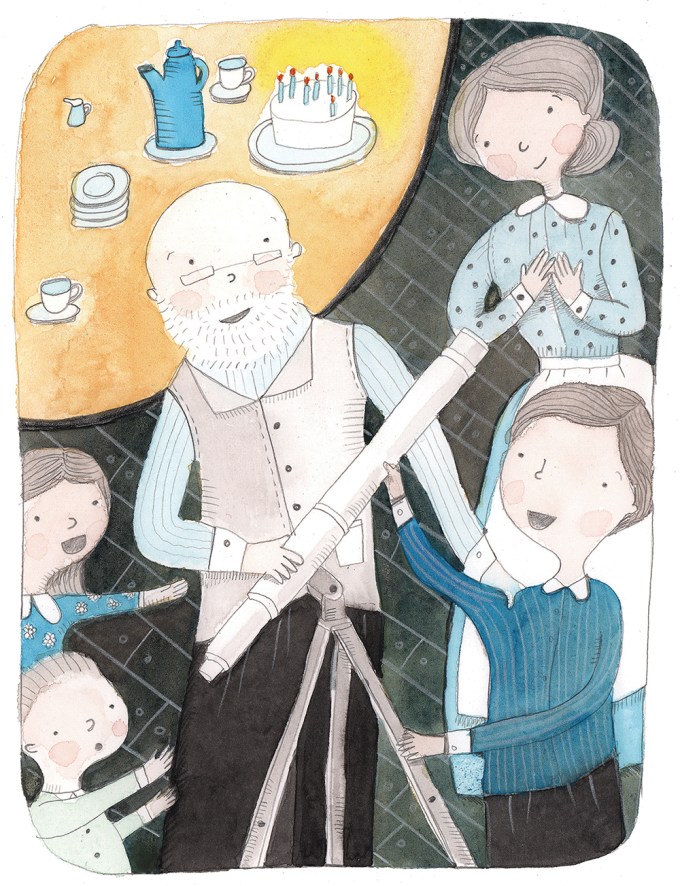The Boy Whose Head Was Filled with Stars: The Inspiring Illustrated Story of How Edwin Hubble Revolutionized Our Understanding of the Universe
INSPIRATIONAL, 1 Feb 2021
Maria Popova | Brain Pickings – TRANSCEND Media Service

“We do not know why we are born into the world, but we can try to find out what sort of world it is.”
In 1908, Henrietta Swan Leavitt — one of the women known as the Harvard Computers, who revolutionized astronomy long before they could vote — was analyzing photographic plates at the Harvard College Observatory to measure and catalogue the brightness of stars when she began noticing a consistent correlation between the luminosity of a class of variable stars and their pulsation period, between their brightness and their blinking pattern.
At the same time, a dutiful boy cusping on manhood was repressing his childhood love of astronomy and beginning his legal studies to fulfill his dying father’s demand for an ordinary, reputable life. That young man was Edwin Hubble (November 20, 1889–September 28, 1953). Upon his father’s death, he would unleash his passion for the stars into a formal study of astronomy. After the interruption of a world war, he would lean on Leavitt’s data to upend millennia of cosmic parochialism, demonstrating two revolutionary facts about the universe: that it is tremendously bigger than we thought, and that it is getting bigger by the blink. The law underlying its expansion would come to bear his name, as would the ambitious space telescope that would give humanity an unprecedented glimpse of a cosmos “so brutal and alive it seemed to comprehend us back.”
Hubble’s Law staggers the imagination with the awareness that even our most intimate celestial companion, the Moon, is slowly moving away from us every day, about as fast as your fingernails grow. This means that at some future point, the greatest cosmic spectacle visible from Earth will be no more, for a total solar eclipse is a function of the glorious accident that the Moon is at just the right distance for its shadow to cover the entire face of the Sun when passing before it from our vantage point — a shadow that will grow smaller and smaller as our satellite drifts farther and farther away. Before Hubble, the study of astronomy had already stunned the human mind with the awareness that this entire drama of life is a miracle of chance, unfolding on a common rocky planet tossed at just the right distance from its star to have the optimal temperature and optimal atmosphere for supporting life. Hubble sent the human mind spinning with the swirl of gratitude and terror at the awareness that it is all a temporary miracle.
Author Isabelle Marinov and artist Deborah Marcero pay tender homage to Hubble’s life and legacy in The Boy Whose Head Was Filled with Stars: A Life of Edwin Hubble (public library) — a splendid addition to the finest picture-book biographies of revolutionary minds, and one particularly dear to my own heart in light of my ongoing devotion to building New York City’s first public observatory to cast the cosmic enchantment on future Hubbles and Leavitts, to make life more livable for the rest of us by inviting the telescopic perspective.
The story begins with the moment the young Edwin’s passion for stargazing is magnified by his first taste of astronomy when his grandfather gives him a telescope for his eighth birthday.
That night, all Edwin wanted was to stay outside, looking up at the stars. Not even a birthday cake could lure him back inside.
Out in the hills of Missouri, under the star-salted skies suddenly so much more proximate and alive, questions fill the wonder-stricken Edwin — questions that become a singsong refrain throughout the book as his life unfolds toward their answers.
One night, watching “the Moon turn into a tangerine” with his best friend, Edwin explains the basic cosmic trigonometry of the lunar eclipse — he is already devouring every astronomy book he can find.
But despite his ebullient passion for the science of the cosmos, Edwin bends to his traditionalist father’s will and trundles down the safe, standard life-path of a high school teacher and basketball coach in Middle America.
Only after his father’s death (the story omits the larger, grimmer dream-interruption of the world’s first global war) does Hubble pursue his dream to study astronomy, completing a degree and taking as his first job a position at Mount Wilson Observatory — home to the largest telescope in the world.
Thinking.
Wondering.
Measuring.
Calculating.On some days, his fingers and toes grew numb and tears froze his eyelashes to the telescope’s eyepiece. But nothing could lure him back inside.
It is there, looking through the colossal instrument night after cold night, that Hubble becomes obsessed with the Andromeda Nebula, then believed to be a swirl of gas and dust within our own galaxy. He begins suspecting it is not.
With this powerful telescope, Hubble identifies previously unseen stars within Andromeda and, drawing on Leavitt’s technique for calculating their distance, suddenly realizes that they were much, much father than previously thought — so far that they could not be within the Milky Way. Which meant that there were other galaxies in the universe beyond our own — a staggering revision of the limits of knowledge.
At this point in the story, in a classic Enchanted Lion touch of thoughtful loveliness and delight, a gatefold expands into a paper spacetime of colorful swirling galaxies, rendering our Milky Way “no more than a small dot in an unimaginably vast universe.”
The story continues with an elegant primer on Hubble’s Law and its humbling, thrilling implications about the universe and our place in it, ending with the inquisitive refrain that had animated the young Edwin’s life and will go on animating the mind of the human animal for as long as we remain sentient creatures on an improbable living world amid a vast and wonder-strewn universe.
Hubble’s own words, evocative of Rilke’s “Ninth Elegy,” appear on the final page as an invocation and an invitation:
We do not know why we are born into the world, but we can try to find out what sort of world it is.
Complement The Boy Whose Head Was Filled with Stars with What Miss Mitchell Saw — the lovely picture-book biography of Maria Mitchell, America’s first female astronomer, whose epoch-making comet discovery helped her blaze the way for women in science — then revisit the astonishing true story of how Kepler laid the foundation of our understanding of the universe while defending his mother in a witchcraft trial.
Illustrations by Deborah Marcero courtesy of Enchanted Lion Books. Photographs by Maria Popova.
_______________________________________
 Brain Pickings is the brain child of Maria Popova, an interestingness hunter-gatherer and curious mind at large obsessed with combinatorial creativity who also writes for Wired UK and The Atlantic, among others, and is an MIT Futures of Entertainment Fellow. She has gotten occasional help from a handful of guest contributors. Email: brainpicker@brainpickings.org
Brain Pickings is the brain child of Maria Popova, an interestingness hunter-gatherer and curious mind at large obsessed with combinatorial creativity who also writes for Wired UK and The Atlantic, among others, and is an MIT Futures of Entertainment Fellow. She has gotten occasional help from a handful of guest contributors. Email: brainpicker@brainpickings.org
Go to Original – brainpickings.org
Tags: Astronomy, Big Bang Theory, Cosmology, Cosmos, Hubble's Law, Hubble's Telescope, Science, Universe
DISCLAIMER: The statements, views and opinions expressed in pieces republished here are solely those of the authors and do not necessarily represent those of TMS. In accordance with title 17 U.S.C. section 107, this material is distributed without profit to those who have expressed a prior interest in receiving the included information for research and educational purposes. TMS has no affiliation whatsoever with the originator of this article nor is TMS endorsed or sponsored by the originator. “GO TO ORIGINAL” links are provided as a convenience to our readers and allow for verification of authenticity. However, as originating pages are often updated by their originating host sites, the versions posted may not match the versions our readers view when clicking the “GO TO ORIGINAL” links. This site contains copyrighted material the use of which has not always been specifically authorized by the copyright owner. We are making such material available in our efforts to advance understanding of environmental, political, human rights, economic, democracy, scientific, and social justice issues, etc. We believe this constitutes a ‘fair use’ of any such copyrighted material as provided for in section 107 of the US Copyright Law. In accordance with Title 17 U.S.C. Section 107, the material on this site is distributed without profit to those who have expressed a prior interest in receiving the included information for research and educational purposes. For more information go to: http://www.law.cornell.edu/uscode/17/107.shtml. If you wish to use copyrighted material from this site for purposes of your own that go beyond ‘fair use’, you must obtain permission from the copyright owner.
















